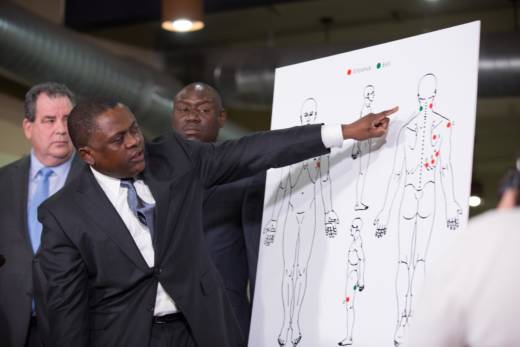The officers arrived about 30 seconds later. One of the officers was recorded on body camera video shouting, "Show me your hands -- gun!" then repeating it before shouting "Gun, gun, gun!" a second before both officers started firing.
A cellphone was discovered near Clark's body.
The Sacramento County coroner's report made public on Tuesday was prefaced by a letter that said Omalu's private autopsy was reviewed by three additional forensic pathologists in the office, plus former Sacramento County forensic pathologist Gregory Reiber, "in an effort to ensure we got the facts correct."
The coroner's report found seven gunshot wounds on Clark's body, and Reiber wrote in his review that Omalu mistook an exit wound on the left side of Clark's chest for an eighth entry wound.
"This is a significant error, as it leads to incorrect conclusions regarding the relative positions of the victim and the shooters during the event," Reiber wrote.
While Omalu said Clark wasn't facing the police when they shot him, Reiber concluded that the body camera and helicopter videos show "there was an initial face-on confrontation," and that Clark was moving toward the officers when they began to fire.
Reiber's analysis also challenged Omalu's conclusion that Clark had been shot primarily from behind. He argued that three of six wounds Omalu had described as being in the back were actually on Clark's right side.
Omalu's statement dismissed Reiber's statement as "inaccurate."
In a joint statement, three civil attorneys representing Clark's family defended Omalu's credibility and criticized Reiber's past association with the Sacramento County coroner.
"It is outrageous, but not surprising, that authorities would attempt to defend the indefensible," the statement by attorneys Ben Crump, Brian Panish and Dale Galipo says. "Stephon Clark was shot in the back, multiple times, while armed with nothing more than a cellphone, posing no real threat to police."
The statement says Reiber "was employed by the County of Sacramento and has been historically pro-law enforcement."
The attorneys point to Reiber's recent testimony to the state Senate Public Safety Committee in opposition to legislation that would require large California counties to use a medical examiner system, independent of county sheriff's departments, to investigate suspicious deaths. Most California counties use a sheriff-coroner system, where the sheriff makes the ultimate determination of manner of death.
The sheriff-coroner system has faced recent criticism, driven in part by Omalu, who resigned as San Joaquin County's chief forensic pathologist in December, alleging interference from Sheriff Steve Moore in cases involving deaths at the hands of law enforcement. Omalu also testified in support of the bill mandating a medical examiner system for large California counties.
Omalu said in his statement that the initial autopsy on Clark -- performed by Sacramento County forensic pathologist Keng-Chin Su -- neglected both basic and advanced procedures that could provide insight into Clark's death.
"To my utter dismay, I observed that none of the gunshot wounds had been previously excised for histologic evaluation," Omalu wrote, referring to a microscopic examination of the tissue around the gunshot wounds. He wrote that his examination of "the wound in question" on back of Clark's left side "demonstrated a gunshot wound of entrance."
Omalu wrote that he also removed the spinal cord and documented significant injuries not identified in the coroner's report.
"At this time, none of the pathologists who have signed the autopsy report and claimed that I was wrong have examined the spinal cord, either grossly or microscopically," Omalu wrote.
Finally, Omalu and the attorneys released a black-and-white photograph of the upper right, back of Clark's body, which shows six gunshot wounds.
"Experts may have different opinions, but a picture is a picture," Omalu wrote. "A picture does not have an opinion."

